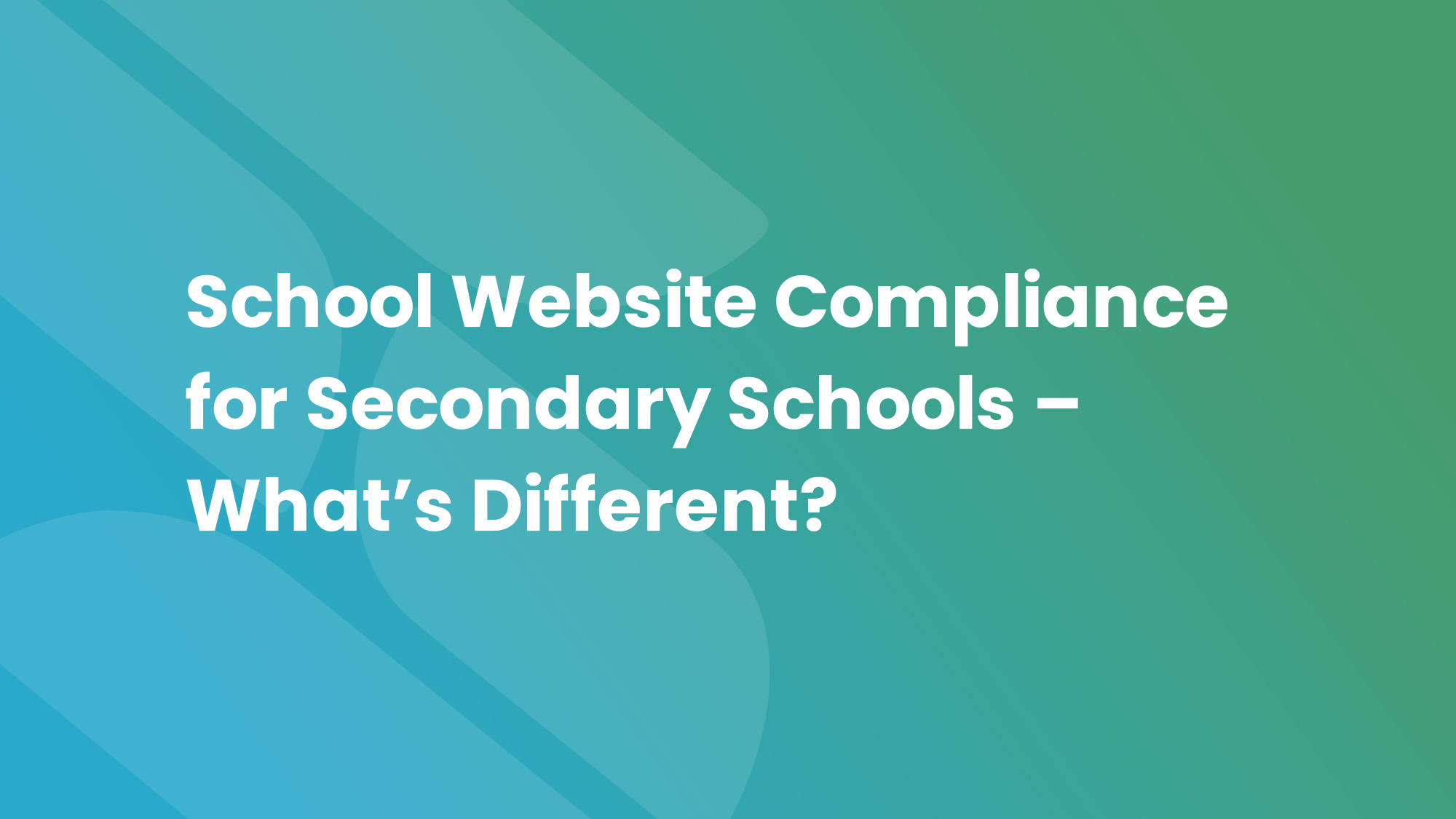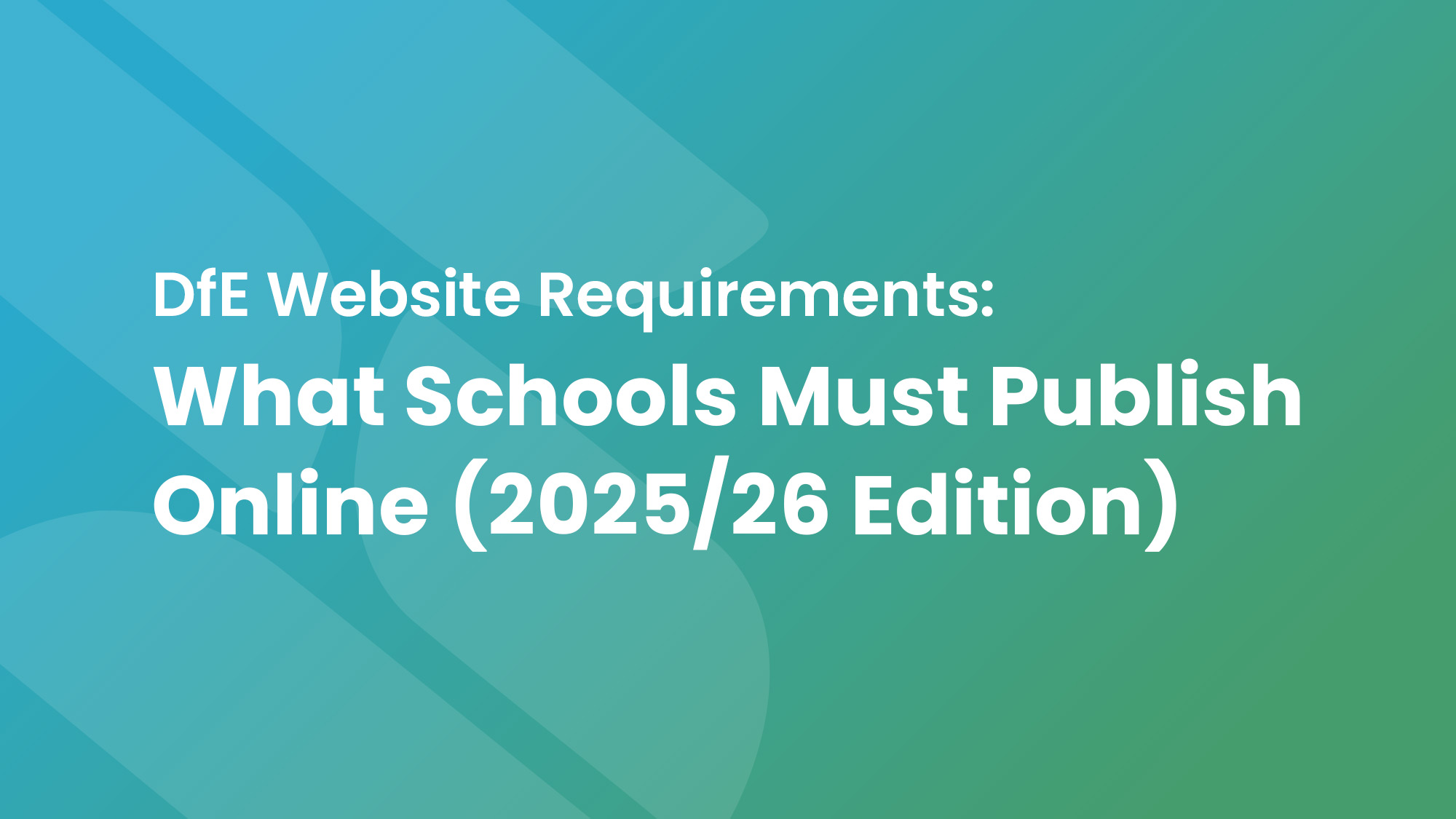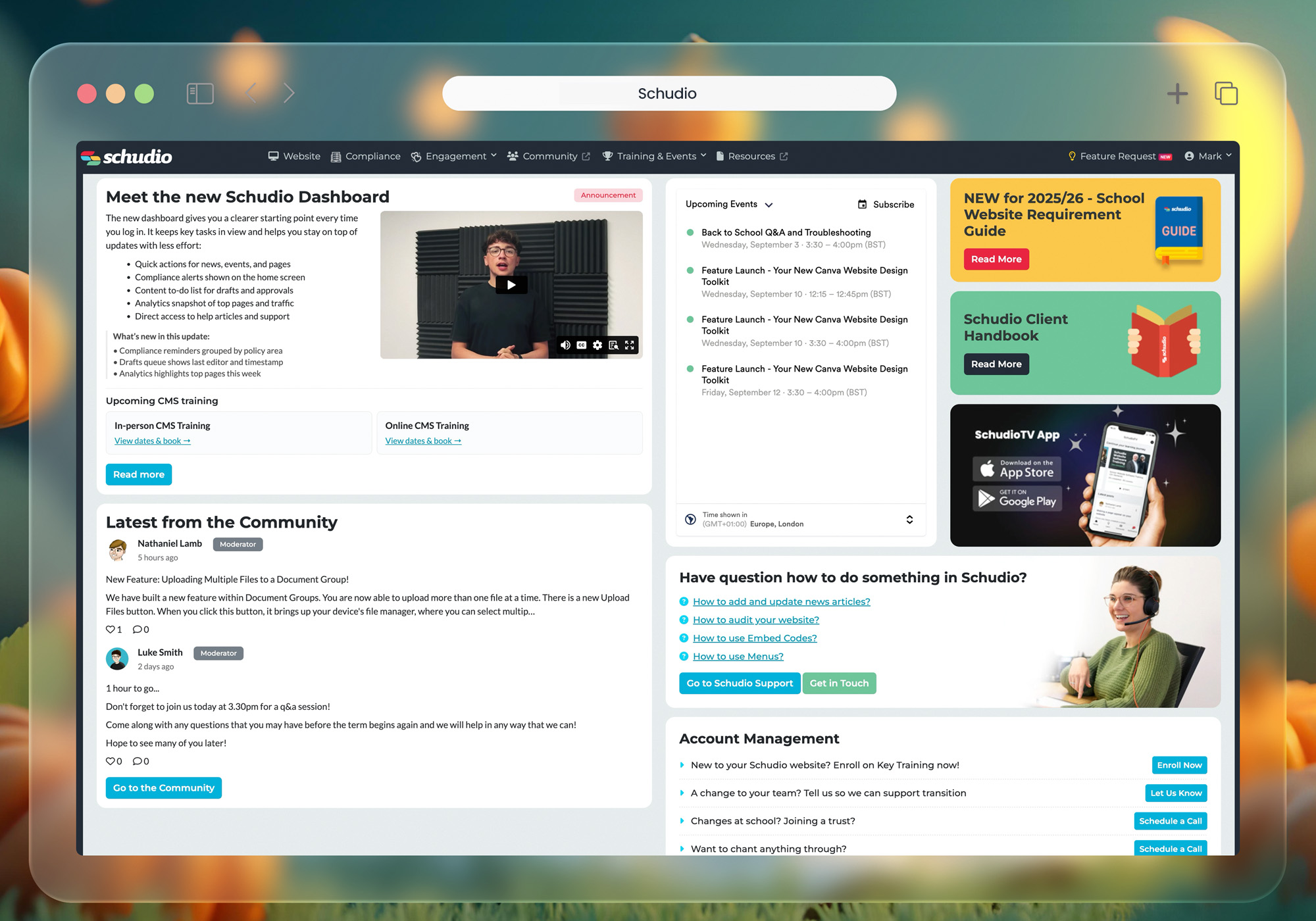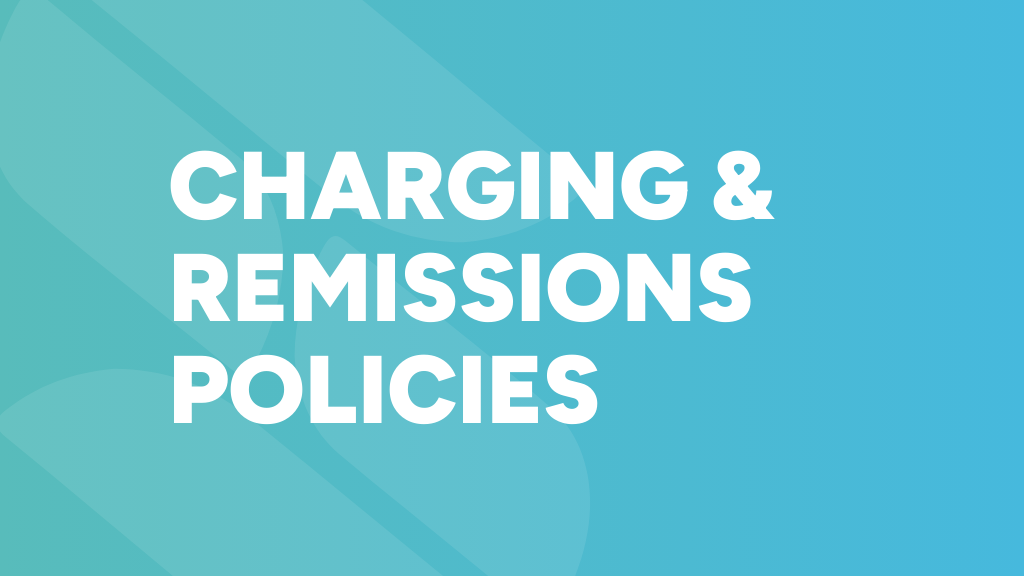School Website Compliance for Secondary Schools – What’s Different?
School Website Compliance for Secondary Schools – What’s Different?

When it comes to school website compliance for secondary schools, the rules are clear—but keeping up with the ever-changing requirements isn’t always easy.
While many of the Department for Education (DfE) website requirements apply to all types of schools, there are distinct responsibilities for secondary schools—especially those with Key Stage 4 and Key Stage 5 pupils. And Ofsted inspections, MAT centralisation, and the growing demands of parents and stakeholders add further pressure. Beyond compliance, there are business benefits to transparency and reporting, such as improved reputation and stakeholder engagement.
In this guide, we’ll walk you through exactly what secondary schools must publish, what makes your obligations different from primary schools, and how to present content in a way that’s accessible, compliant, and meaningful to students, staff, and families.
Why Does Website Compliance Matter for Secondary Schools?
Your school website is one of the first places parents, inspectors, and prospective students look. It’s a public record of your compliance with statutory guidance, a window into your curriculum and values, and a crucial tool in promoting your school to your relevant age group and wider community.
Whether you’re a maintained school, academy, free school, or part of a trust, your website must reflect your school’s intent, values, curriculum, policies, and performance—clearly and accessibly. And for secondary schools, this includes additional responsibilities such as:
- Careers guidance
- Curriculum at KS4 and post-16
- Gender pay gap information (if applicable)
- Destinations data
- Detailed governance information
- EBacc average point score and performance measures
What Secondary Schools Must Publish on Their Website (2025/26)
Let’s break down the core DfE website requirements for secondary schools and highlight where they differ from the expectations for primary schools.
1. Contact Information
Your website must publish:
- The school’s name, postal address, telephone number, and email address
- The name of the headteacher or principal
- The name and contact details of the staff member responsible for queries from the public (usually the school office)
- For academy trusts, details of the trust’s registered office, company number, and trustees
2. Admission Arrangements
You must publish how admissions are managed:
- Maintained schools: Link to your local authority’s website, as the local authority manages the school’s admission and appeal processes, including the publication of admission policies and appeal arrangements for community and voluntary-controlled schools.
- Academies: Publish your admissions policy, including oversubscription criteria and how to apply
- Secondary schools must also explain how they manage in-year applications, and publish their published admission number (PAN) and appeal arrangements. If the local authority manages in-year applications, you must provide a link to the local authority’s in-year coordination scheme.
Schools must also publish a timetable for admission appeals and explain how parents can hear admission appeals, in line with official guidance.
If your school is selective or receives many external applicants, these details must be clearly explained.
3. Curriculum Information (Key Stage 3, 4, and 5)
This is a major area of differentiation.
For each key stage, you must publish:
- The content of the curriculum for each subject and year group
- The music curriculum and the music development plan as part of your statutory requirements, including templates to support this process
- Details of mandatory subjects, such as religious education, citizenship, PSHE, and relationships and sex education (RSE)
- The school’s approach to careers guidance and technical education
- How you meet the national curriculum requirement (for maintained schools)
- How to request further information
For Key Stage 4, you must also publish:
- A list of GCSEs and qualifications offered
- Whether the school offers the English Baccalaureate (EBacc) and how
- Details of performance measures, including progress scores, average point scores, and attainment 8
Where relevant, Key Stage 5 (post-16) should include:
- A list of courses offered
- Any 16–19 study programme guidance
- Destinations data: where students go after leaving school
📌 Tip: Use HTML pages with expandable sections rather than PDF documents—these are easier to navigate, more accessible, and mobile-friendly.
4. Examination and Performance Data
For secondary schools, the DfE has published strict guidance on what performance data must be published. This includes:
- Progress 8 and Attainment 8 scores
- EBacc average point score
- % of pupils entering and achieving the EBacc
- Destinations (education, training, employment) for pupils finishing KS4 and KS5
- Publish progress scores: Schools must publish their progress scores for each key stage.
Schools should also publish pupils’ average scaled score and maths progress measures, where applicable.
Note: While primary progress measures are more relevant for primary schools, secondary schools should be aware of how to calculate primary progress measures for transition data, especially considering the impact of Covid-19 disruptions on assessment and reporting.
Even if results are temporarily not available due to unusual academic years, you must link to the DfE performance tables and include your own performance measures page where required.
5. Ofsted Reports
All schools must:
- Link to the latest Ofsted report
- Provide a summary of the outcome
- For academies, also link to predecessor schools’ inspections where relevant
6. Safeguarding and Welfare Policies
Your website must publish:
- The school’s Child Protection Policy
- Safeguarding policies
- The name and contact details of your Designated Safeguarding Lead
- For larger schools, this may include deputies, safeguarding governor, or LADO contacts
- An up-to-date accessibility plan to demonstrate how disabled pupils access the curriculum and school environment
- A SEND (Special Educational Needs and Disability) policy that details your approach to supporting students with special educational needs, including designated staff, relevant policies, and compliance with the Special Educational Needs and Disability Regulations 2014
As part of your public sector equality duty, you must also publish:
- Your equality objectives
- A policy statement outlining your compliance
If you receive pupil premium funding, your pupil premium spending strategy must also be published and updated annually.
7. School Policies and Statutory Documents
Secondary schools must publish:
- Behaviour policy
- Complaints procedure
- SEND policy and report
- Charging and remissions policy
- Careers programme details (including provider access policies)
- RSE and health education policies
- Remote education provision (if applicable)
- Privacy notices for pupils, parents, and staff
- Annual governance self-assessment (if conducted)
- Information about committee members, including their names, roles, and relevant interests, in line with statutory guidelines
- Governors’ relevant business interests, including financial, pecuniary, and other relevant business interests, ensuring compliance with data protection and diversity considerations
If you are a trust school or part of a multi-academy trust, you must also include:
- Funding agreement
- Annual accounts
- Executive pay information
- Trustees’ financial and pecuniary interests
- Governance roles including local governing bodies and committees
For schools maintained by local authorities, there are specific statutory obligations to publish certain information under the Education Act 1996.
8. Financial Transparency
For academies and trusts, financial transparency has become a major area of scrutiny.
You must publish:
- Latest audited annual accounts
- Gender pay gap information (if you employ more than 250 staff)
- Ethnicity pay gap information (voluntary, but recommended to support pay equity and demonstrate commitment to diversity and inclusion)
- Executive pay (anyone earning £100,000 or more)
- A statement on carbon reporting disclosure, equivalent where applicable
Most public authority employers, including schools, are generally exempt from certain publishing requirements but may choose to publish additional information voluntarily to promote transparency and best practice.
Even voluntary aided schools and maintained schools must publish governor information and financial interests where required.
All published financial and governance data should be easily accessible on the school website to ensure transparency and compliance with legal requirements.
Presentation & Accessibility Best Practice
Use HTML, Not Just PDFs – But Make the Most of What You Have
For secondary schools, we know curriculum content and policy documentation is often still stored and shared as PDFs. This is understandable—especially when you’re working with large documents or standardised templates from awarding bodies and local authorities. But there’s an important shift happening that schools need to prepare for.
The DfE and the wider public sector are moving away from PDF as the primary format for publishing information. The reason? PDFs are harder to read on mobile, often inaccessible for users with additional needs, and not easily translated or searchable. HTML is now the clear preferred standard.
That doesn’t mean everything has to change overnight. At Schudio, we’ve built tools to bridge the gap — and make the most of your current PDFs while supporting a transition to more accessible content.
🗂️ How Schudio’s Document Groups Make Embedded PDFs Work Smarter
Our CMS includes a powerful feature called Document Groups, which allows you to:
- Embed PDF documents directly within your HTML pages
- Automatically apply the correct formatting and display settings for mobile devices
- Ensure that your content is tagged, structured, and accessible
- Present related documents (e.g. policies, curriculum plans, timetables) in a grouped, filterable way
- Keep everything in one central place, with real-time updates across the site if a document is changed
This feature allows schools to continue using some existing PDF workflows without losing accessibility or compliance points. For example, your full Music Development Plan or RSE policy might still be a PDF, but when embedded via a Schudio Document Group on a well-structured HTML page, you still give parents and inspectors a great experience.
📱Why Start Moving to HTML?
That said, the long-term direction is clear: schools should increasingly publish core content as HTML, not just as downloadable files.
Why?
- HTML is searchable, translatable, and works across all screen sizes
- It’s easier for parents and inspectors to navigate and understand
- It meets the latest accessibility legislation (WCAG 2.2, level AA)
- It allows your school to show intent, implementation, and impact clearly and in context
- It supports powerful future tools, like automated compliance checking and live updates via the Schudio MAT Portal
We recommend starting with curriculum pages, key policy overviews, and governance or financial information. These are the areas Ofsted and stakeholders check first—and they’re also the most valuable for prospective students and parents.
✅ Our Recommendation
Use PDFs strategically, but don’t let them be the only way content is accessed.
- Use Document Groups to embed PDFs smartly in the meantime
- Gradually convert your most important content to HTML, especially curriculum content, policy summaries, and compliance items
- Always publish an accessibility statement that reflects this transition and explains how your site is improving access year on year
Need help reviewing what should stay as PDF and what should move to HTML? We can help—through our manual audits, CMS training, or even as part of our full Content Design Refresh service.
What’s Different for Secondary Schools?
While the fundamentals of compliance apply to all schools, secondary schools face:
- Greater scrutiny from parents and Ofsted due to size, complexity, and outcomes
- Broader curriculum offers across multiple key stages
- A wider audience: prospective students, sixth formers, employers, and universities
- More content to manage: performance measures, exam subjects, destinations data, careers guidance
- More complex governance and policy structures—especially for academies and MATs
Secondary schools should also develop and publish a schools plan, such as a strategy statement for pupil premium funding, to demonstrate effective use of resources and provide annual updates.
MATs and Secondary School Compliance
For Multi-Academy Trusts (MATs), overseeing website compliance across a group of secondary schools can quickly become overwhelming. With each school needing to meet the full list of DfE website requirements, including all the additional elements that apply specifically to secondary settings—such as detailed curriculum content, KS4 performance data, and destinations information—it’s essential that Trusts have a clear, standardised system in place.
From a governance perspective, you’re responsible. If one school’s website is out of date, missing statutory content, or inaccessible to parents or inspectors, the trust is ultimately accountable.
That’s why MATs need to:
✅ Standardise Website Structures Across All Schools
A consistent structure doesn’t just make things easier for families and inspectors—it dramatically reduces the internal workload for school staff and trust leads. With a shared framework, schools aren’t reinventing the wheel. Everyone knows where content should go, and what “done” looks like.
At Schudio, we help MATs adopt a shared page layout structure that still allows each school to retain its identity—but within a robust, fully compliant framework that evolves with DfE requirements.
Ensure Governance and Financial Information is Consistent
Secondary schools are required to publish a broad range of compliance information—from funding agreements and annual accounts, to governance details and gender pay gap information (where applicable). These pages need to be consistently presented and reliably maintained across all your school websites.
We often see Trusts where some school sites publish this data well, while others are out of date or hard to navigate. That can be a red flag for inspectors or auditors—especially when reviewing trust-wide governance and accountability.
Provide a Single Source of Truth for Compliance Oversight
This is where most trusts run into trouble. Relying on manual spreadsheets, asking schools to “please update your policy pages,” or chasing the latest safeguarding lead name via email is inefficient—and risky.
That’s exactly why we built the Schudio MAT Portal.
How the Schudio MAT Portal Helps Trusts Stay Compliant
Our MAT Portal gives trust teams real-time visibility and control of every school’s website compliance status. It’s the only solution designed specifically for UK school compliance teams and is already in use by some of the country’s most forward-thinking MATs.
Key features include:
- ✅ Compliance Dashboards for each school, with traffic-light indicators showing which requirements are met, at risk, or overdue
- ✅ Centralised Policy & Document Sharing – publish once and push across all school websites in seconds, reducing repetition and errors
- ✅ Full Audit Trail – track which documents have been updated, when, and by whom
- ✅ AI-Powered Compliance Reviews (coming soon) – automate regular scans of each website to flag potential gaps or expired documents
- ✅ Custom Permissions – allow local control where needed (e.g. Heads or DSLs updating key pages) but maintain trust-wide visibility
- ✅ Integrated Analytics – see how parents and inspectors use key content like curriculum pages, policy downloads, or contact forms
A Smarter, Simpler Way to Meet Your Legal Duties
Whether you’re managing 4 secondary schools or 40, our MAT Portal is designed to lighten the load on school staff, while giving central teams the confidence that every website is accurate, up to date, and inspection-ready.
We also provide onboarding support, training for all key users, and termly audits, so your team is never left on their own to manage the detail.
Or attend one of our free monthly compliance workshops to hear how other MATs are using it to stay ahead of changing requirements.
What’s New for 2025/26?
Recent updates affecting secondary schools include:
- Renewed focus on executive pay transparency
- Clarified expectations for gender pay gap information
- More robust requirements around careers programme delivery and provider access
- The need to clearly document curriculum breadth and intent
- Pressure to reduce reliance on inaccessible PDFs
- Optional inclusion of your Music Development Plan as part of broader enrichment transparency
- Requirement to publish clear and accessible school uniforms policies, in line with recent legislative updates
- Updates affecting both secondary and primary school requirements, especially regarding statutory guidance for Key Stage 2
- Need to publish information on sport premium funding and compliance with reporting deadlines
Final Thoughts
Secondary school website compliance isn’t just about ticking boxes—it’s about providing a clear, accessible, and trustworthy picture of your school to parents, pupils, and inspectors.
To make this easier, we offer:
🎓 Live monthly compliance workshops – with live audits
🔍 Expert manual website audits – tailored to secondary school needs
🧠 Compliance tracking tools & AI assistance – via the Schudio platform
🔗 Book your free place at our next workshop










